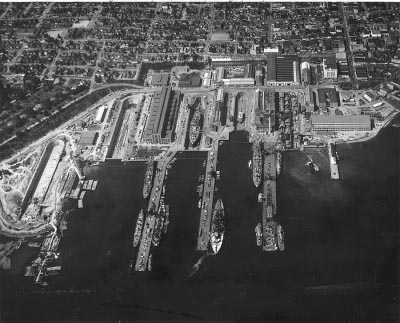![]() The Pacific War Online Encyclopedia
The Pacific War Online Encyclopedia
|
| Previous: Ships | Table of Contents | Next: Shiraishi Kazutaka |

Naval History and Heritage Command #NH 84926
Shipyards are facilities for the construction and repair of ships. They are
located
near major ports with good rail
access to steel works
and other
industrial facilities necessary to support their activities. The
shipyards of the 1940s had extensive foundries and machine shops
to
construct ship components, but their distinctive feature was the
building slipways ("ways" for short) at the water's edge where
ships
were assembled. These huge concrete
ramps were equipped with massive
cranes and their own rail system for moving the steel assemblies that
went into the construction of the ships. A way cost about
$500,000, plus about $30,000 for the two Morgan cranes required to
lift bulkheads into place.
Ship hulls were assembled on wooden (traditionally oak) cradles in the ways. When the hull was complete, the cradles were greased and the hull was allowed to slip down the way into the water, an occasion traditionally marked with much ceremony. Installation of engines and superstructure (the fitting out of the ship) generally took place after she was launched. Hence, ship histories usually record both a launch date and a completion date, often months apart.
Construction of a ship could be divided into four
stages: receipt, fabrication, assembly, and erection. Receipt
referred to the delivery from the yard's suppliers of steel plate
and other raw materials and their organization into storage yards.
Fabrication was the process of cutting and bending steel plate and
other materials into the shapes required for assembly. Assembly
was the riveting or welding together of shaped steel plates and
other materials into parts of the ship. These were then riveted or
welded together on the way to construct the ship. Only this last
step, erection, was usually accounted for in the time from keel
laying to delivery, so that construction times could be
misleading. However, the time on the ways and in fitting out was
the usual bottleneck in construction.
The war saw unprecedented application of mass production techniques to American shipbuilding, which increased overlap between the four construction stages. California Shipbuilding Corporation typically began assembly when fabrication was only 30% complete and erection when assembly was only 25% complete, compared with assembly beginning when fabrication was over 50% complete and erection when assembly was over 80% complete in yards using more traditional methods. Preassembly increased the manpower required per way, but reduced the man hours per ship completed. Oregon Shipbuilding, which made heavy use of preassembly, required 2400 men per way, while South Portland, which used little preassembly, employed 710 men per way. However, Oregon Shipbuilding required 352,000 man hours to construct a Liberty Ship, versus the average of 574,000 for all yards. Portsmouth Navy Yard made extensive use of prefabrication to minimize time on its limited number of ways, setting a record of 56 days from laying down to launch of submarine Cisco. The requirements of mass production led to some friction between the Navy and private contractors. For example, Electric Boat Company, a major private manufacturer of submarines, focused on rapid, economical mass production of basically sound boats, completing Corvina in a record 317 days from laying down to commissioning. However, the Navy was continually demanding the latest improvements to the boats, which worked against streamlined and rapid construction.
Preassembly favored welding, which was most easily done on the ground or in a fig instead of within a partially assembled ship hull. Preassembly also required powerful cranes to lift preassembled sections weighing 50 tons or more. This meant that the American shipyards of the Second World War tended to be organized as "vertical yards", with a relatively small amount of waterfront, instead of as "horizontal yards" like those of the First World War. Most of the assembly work took place a thousand yards inland and was erected on a relatively small number of ways, but with a much shorter time on the way for each ship. Such yards required considerable space around the fabrication and assembly shops.
Construction effort naturally depended on the complexity
of the ship being constructed, with capital ships requiring a vast
investment in manpower. Transports
required about 50% more man hours than Liberty Ships, while tankers required about 30% more
effort. Escort carriers
produced by Kaiser required about as many man hours as transports.
Ships require periodic maintenance, which in the case of
warships takes the form of extended refits. For example, a
submarine required refit after about six patrols. This refit
required about 32,000 man-hours of work, which took about 85 days
in a naval yard such as Mare
Island.
The construction capacity of a shipyard can be characterized in several ways. The most important of these are:
Floor space. This is the
area of the manufacturing plant associated with the shipyard,
measured
in thousands of square feet (square meters).
Building way length. This
is
the total length of all building slipways, measured in feet
(meters).
Merchant Ship Tonnage. This is the average monthly gross tonnage of merchant ships produced in the yard during the war.
Naval Ship Tonnage. This is the average monthly displacement tonnage of warships produced in the yard during the war.
References
The Pacific War Online Encyclopedia © 2007, 2011, 2013-2014, 2016 by Kent G. Budge. Index